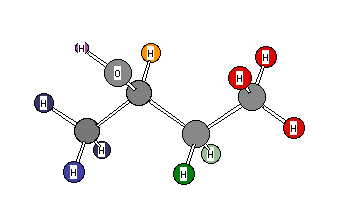Formula: C4H10O
Answer: 2-Butanol (sec-Butyl alcohol)
1H NMR: Chemical Shift Assignments: δ 0.92(t, 3H), 1.18 (d, 3H), 1.47 (2H, multiplet), 2.12 (1H, broad s), and 3.72 (1H, sextet)
The degree of unsaturation is zero. The compound is either a saturated alcohol or a saturated ether. The broad 1H singlet at δ 2.12 indicates an -OH. We have an alcohol. We can use a little psychology here because there are only four saturated butanols. Ignoring the -OH groups, they are, arranged in increasing spectral complexity: 2-methyl-2-propanol (t-butyl alcohol, 1), 2-methyl-2-propanol (isobutyl alcohol, 3), 1-butanol (n-butyl alcohol, 4), and 2-butanol (sec-butyl alcohol, 5). [The bold numbers are the number of different types of hydrogens bound to carbon.] Draw their structures. Does this mean that the answer should be n-butanol because there are four chemical shifts unassigned? n-Butanol has only one high field 3H triplet. This compound has two high field 3H signals (methyl groups) that are non-equivalent: δ 0.92 and 1.18 . Only 2-butanol satisfies this requirement in addition to the observed coupling. The low field signal at δ 3.72 is a sextet by virtue of the coupling to five vicinal hydrogens. The hydrogen atoms of the methylene group are diastereotopic (they are different) and may have different chemical shifts and couple to one another as well as their neighbors. Because geminal coupling is usually larger (J = ~10 Hz) than vicinal coupling, and Δ δ ~ J, the signal can be, and is complex. Take a close look at the blown-up region at δ 1.47. Note how it looks somewhat symmetrical about δ 1.47. The actual chemical shifts of the two diastereotopic hydrogens are ~δ 1.45 and 1.50. In the structure below, the diastereotopic hydrogens are colored different shades of green to indicate that they are very similar but different. Diastereotopic hydrogens are more readily detected on higher field instruments owing to increased resolution. Although diastereotopic hydrogens are inherently different, they may fortuitiously have the same chemical shift and not resolve. This also means that they will not couple.
The 13C NMR spectrum has four singlets. Of the four possible alcohols of this formula, only 1-butanol and 2-butanol can fit this spectrum. Return to Menu.
 |
oxygen-yellow |
|---|